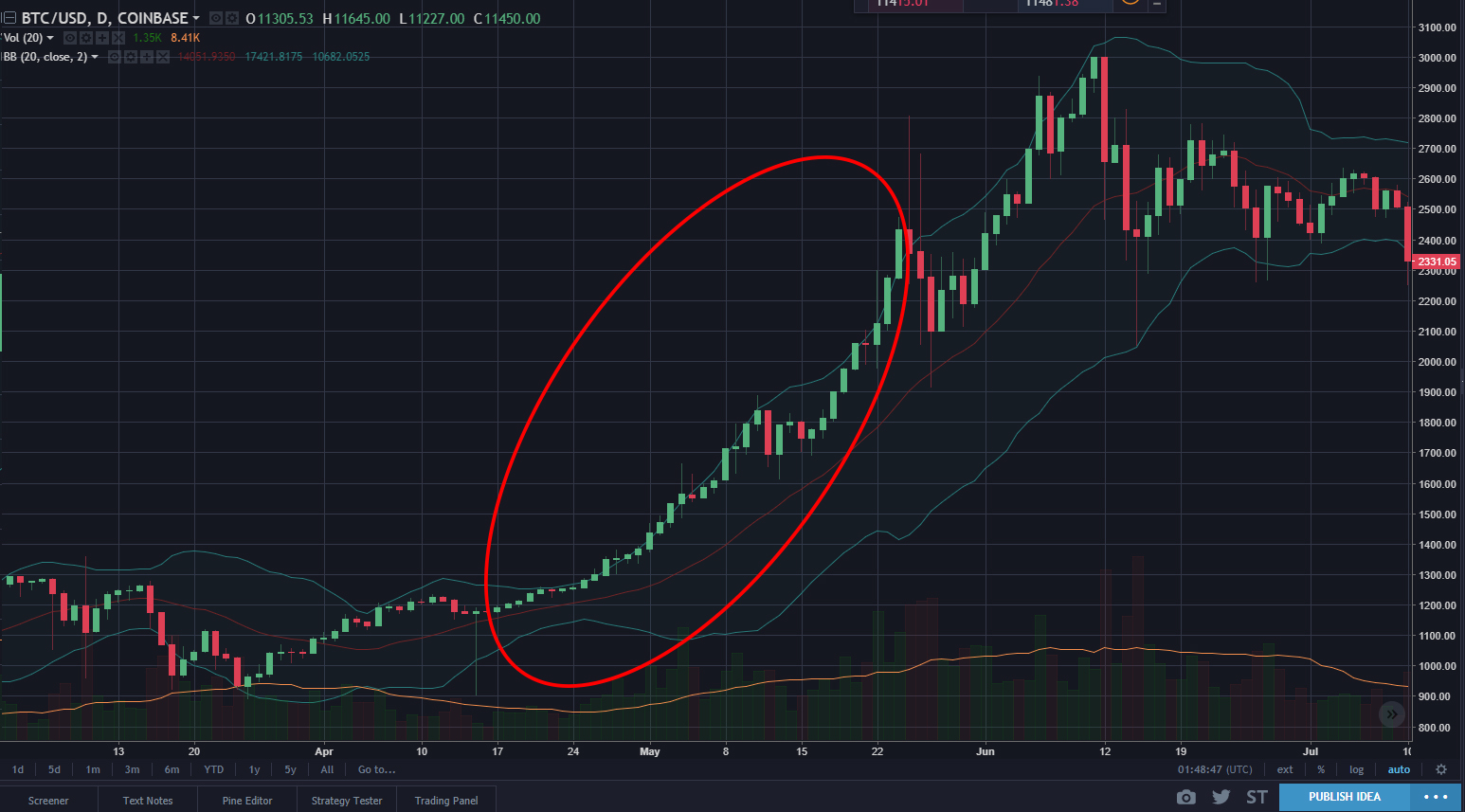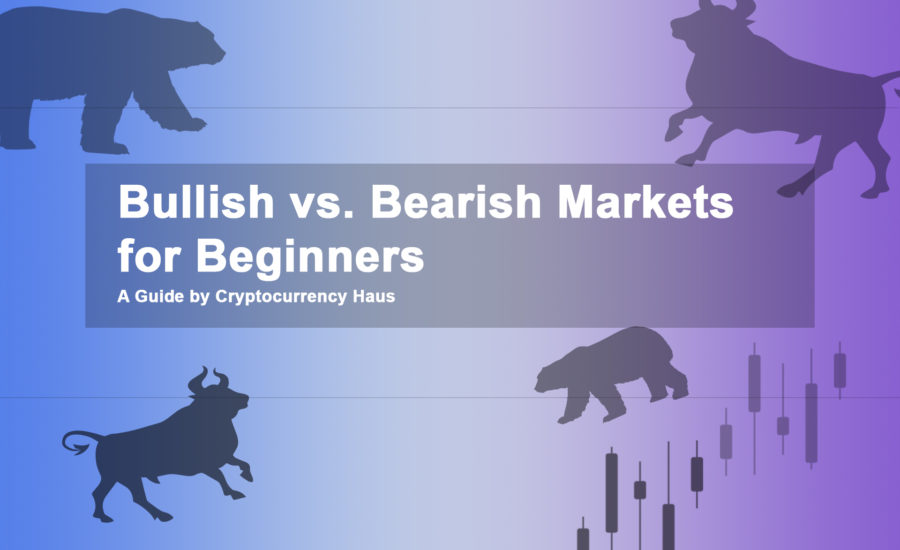Source: https://cryptocurrencyhaus.com/bullish-vs-bearish-markets/
If you watch cryptocurrency-related news, read headlines and social media posts, you’re bound to frequently come across the terms “bearish” and “bullish.” These terms are used within any type of financial markets that involve trade, whether those be the traditional stock markets, or cryptocurrency markets. As you’re going through your heart-pounding investment journey, it’s very important to understand what these common terms mean and how they affect you as an investor.
In general, we use the terms bullish and bearish to describe the state of where a market is at. More specifically, if the market is in an uptrend (gaining value) or a downtrend (losing value). These up-trends and downtrends are typically reflective of investor emotion. You’ll typically see a market’s value rise in the midst of positive news, and fall in the presence of negative news. Sometimes other works may be at play to influence a market in unforeseen ways, such as “pump and dump” groups (do not recommend) who strategically buy large amounts of a currency to drive up prices, and then all sell off for a gain.
“Come fill the South Sea goblet full;
The gods shall of our stock take care:
Europa pleased accepts the Bull,
And Jove with joy puts off the Bear.”
The gods shall of our stock take care:
Europa pleased accepts the Bull,
And Jove with joy puts off the Bear.”
-Alexander Pope, 1720
The Bullish Market
A bull market is used to describe a market that is increasing in value. You’ll typically see this term thrown around when there is a consistent increase in price of an asset. This signifies that confidence in the market is high, and investors are feeling optimistic about the state of the market. You may be a bullish investor if you plan to buy and hold your assets for the long term, in confidence of gaining a profit in the future.
History of the Bull Market
Bull Attacks
The term for the bull market originated sometime around 1714, yet there are many stories around exactly where the term “bull market” originated from. One theory comes from the way that a bull attacks an opponent. The bull lowers its head, and uses its horns in an upward fashion to thrust into an opponent. In the market, this is seen when the market is low, and starts to climb. to thrust its opponent up in the air. Hence, a bull market comes out of the market having been low, and then rapidly climbing.

Bull Blood Sport
Another theory comes from the Elizabethian era in the late 1500’s. During this time there was a blood sport which was called “bull baiting.” This was a cruel sport in which spectators would watch a chained bull be attacked by a group of dogs. Thankfully, this sport was banned in 1835. The time-frames line up fairly well with the term origin, so some believe this blood sport is where the term began.
The Bull Board
The final common theory originates from The London Stock Exchange. This exchange was established during the 17th century which lines up well with our 1714 term-origination date. During the early years of the exchange, the bulletin board that traders posted stock purchase offers on was typically called a “bull.” When there wasn’t much demand for a stock, the board would be “bare.” Make sense?
How to Identify a Bull Market
A bull market can be identified by a few different key factors outside of simply observing a consistent upward trend. These factors are not always correct, but are simply general guidelines of what you can start to look for to identify the bullish market.
- Basic Economics – Supply and Demand: During a bull market, there is a lot of optimism and confidence so we typically see strong demand for an asset with dwindling supply. Not many investors are keen on selling since confidence is high, and many are looking to buy into the market. Due to this, prices will rise. Demand > Supply = Increased Rarity; Increased Prices
- Economic Health – Typically, when the economy is healthy, people have more money to spend. A bullish market can be a characteristic of a healthy economy as investors have more “play” money to spend on assets.
- Human Psychology – Ever see bad news on your favorite currency and the value takes a dip? This is due to simple, human behavior and psychology. The thoughts and feelings of investors behind a market are a key driving force between rises and falls. During a bull market, confidence is high and investors are optimistic about becoming profitable.

For long-term purposes, you can use the day candles on your favorite trading platform to look at past trends and seeing where bull markets have occurred. You can even find important news around the bullish market dates to see how the market reacted to different kinds of news, and can be better prepared to invest when similar news occurs.
The Bearish Market
The bear market, or a market that is “bearish” describes a market decreasing in value. Opposite of a bull market, when you see a consistent decline in the price of an asset, you’ve most likely identified a bear market. Confidence in this market is low, which steers many investors away from the asset.
History of the Bear Market
Bear Attacks
As with the bull market, the term for the bear market originated in or around 1714. The first theory for the bear market terminology comes from how the bear attacks. Imagine a bear swiping it’s huge paws downwards, slashing an opponent. This symbolizes the downward trend we see in the bear market.

Bear Baiting
“Bear baiting” falls under the same premise as the bull theory. In the late 1500’s it was also said that bears would be chained up and attacked by dogs for spectator sport. Some believe the term was originated from this sport during the time when this blood sport was legal.
The Bare Board
During the origination of the The London Stock Exchange, there was a board where traders posted offers to buy stocks. When demand for stocks was low, the board was bare which was said to coin the term “bear” for when the market is down.
Bearskin
In the 16th century, selling animal pelts was a decent way to earn a living. Like many products, there sometimes involved a middleman to help sell the bearskin pelts. These shady salesmen took part in a practice where they would sell bearskin that they actually didn’t have. They’d simply guess at the price they would have to pay the huntsmen for the bearskin. To make a profit, these salesmen would estimate a price to sell the bearskin at which would need to be higher than the huntsmen would charge.

During this time, a popular slogan was “don’t sell the bear’s skin before you’ve killed them.” As you can imagine, there were most likely some of these salesmen who lost their shirts from under-pricing their pelts. At the start of the 18th century, investors started to sell stocks they didn’t even own, hoping to purchase the stocks at a later time cheaper than they sold them for (short selling). This short selling practice was known as “selling the bearskin” due to the common history in this type of activity.
How to Identify a Bear Market
A bearish market can be identified with the same core factors as a bullish market, just with opposite details. You’ll see that the value of an asset is in a consistent decline. These below factors are not always accurate in determining a bear market, but are a good starting point.
- Basic Economics – During a bearish market, supply is high and demand is low. In basic economics, when supply > demand, the price drops. This means that more people are willing to sell than they are to buy.
- Economic Health – A bear market can sometimes be associated with a weak economy. Investors will have less money to spend during weak economic times, and a downward trend may cause investors to stay even further away.
- Human Psychology – Human emotion and psychology drive the market. Sometimes we will find a bear market when market confidence is down which may be due to any number of factors. The FUD (fear, uncertainty, and doubt) factors can cause a downtrend. Investors may be moving their money into more stable assets during this time. Because the market is unpopular, this can shake investor confidence and cause other investors to stay away from the asset. This causes a price decline in the market.

A bear market can be a great time to start using some trading indicators to see if an asset may be over-sold. This offers the chance for investors to potentially invest in a promising asset at a discounted price.
In conclusion, looking at historical market trends can be helpful in identifying bullish or bearish markets. We hope you enjoyed this summary of bullish vs. bearish markets! Let us know what we missed!

3 Replies to “Bullish vs. Bearish Markets for Beginners”